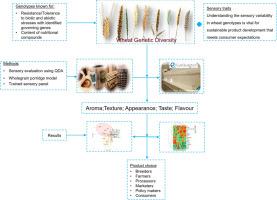味觉多样性:气候变化条件下粮食生产中小麦的感官特征
IF 8.2
Q1 FOOD SCIENCE & TECHNOLOGY
引用次数: 0
摘要
为了确保气候变化下的生产可持续性和粮食安全,必须通过从不同来源转移合适的性状来提高主要作物的抗灾能力和营养质量,同时保持消费者偏好的感官属性,以支持接受和采用。因此,本研究以全麦粥为模型,采用定量描述分析方法,对17个遗传群中不同小麦基因型(n = 49)的13个性状进行了感官特征评估。结果显示,所有13种感觉性状的基因型差异显著(p < 0.001)。黑麦渐渗系(如1rs、1bl +2BS)。2RL、2R/2B、1R+6R)和老品种在气味描述因子(全麦面粉、黑麦面粉、玉米、熟米)上表现出更高的强度,质地更紧实,颜色明显为灰色/米色。古小麦品种,如einkorn,斯佩尔特小麦和Triticum timopheevi表现出较温和的香气和风味特征,甜度高于其他被评估的小麦类群。仙人掌和长白的特点是苦味、鲜味和粗糙的口感。气味性状之间存在显著正相关(r = 0.68 ~ 0.91),质地粗度与苦味之间存在显著正相关(r = 0.67)。甜度与气味和风味性状呈中等至强烈的负相关(r = -0.42至-0.75)。多变量分析解释了总方差的63.3%,并将基因型聚类为三个不同的感觉强度类别。这些发现突出表明,当弹性和营养基因从不同的小麦基因型转移到适应性小麦,并从这些材料开发出新的食品时,感官属性可能带来机遇和挑战。本文章由计算机程序翻译,如有差异,请以英文原文为准。

The taste of diversity: Sensory characteristics in diverse wheat aimed for food production under climate change
To ensure production sustainability and food security under climate change, it is essential to improve the resilience and nutritional quality of staple crops by transferring suitable traits from diverse sources, while maintaining sensory attributes preferred by consumers to support acceptance and adoption. Therefore, the present study evaluated sensory characteristics using 13 traits, in a diverse wheat genotype (n = 49) belonging to 17 genetic groups, by Quantitative Descriptive Analysis, a trained panel, and using wholegrain porridge as a model. The results revealed significant genotypic differences (p < 0.001) for all 13 sensory traits. Rye-introgressed lines (e.g., 1RS.1BL+2BS.2RL, 2R/2B, 1R+6R) and old cultivars exhibited higher intensity for odour descriptors (graham flour, rye flour, corn, cooked rice), firmer texture, and distinct grey/beige colour. Ancient wheat species, such as einkorn, spelt, and Triticum timopheevi showed a milder aroma and flavour profile and higher sweetness than the rest of the evaluated wheat groups. T. carthlicum and landraces were characterised by bitterness, umami, and a gritty mouthfeel. Strong positive correlations were observed among odour traits (r = 0.68–0.91), while texture grittiness correlated with bitterness (r = 0.67). Sweetness showed moderate to strong negative correlations with odour and flavour traits (r = -0.42 to -0.75). Multivariate analysis explained 63.3% of the total variance, and clustering grouped the genotypes into three distinct sensory intensity classes. These findings highlight that sensory attributes may pose opportunities and challenges when genes for resilience and nutrition are transferred from diverse wheat genotypes to adapted wheat and novel food products are developed from these materials.
求助全文
通过发布文献求助,成功后即可免费获取论文全文。
去求助
来源期刊

Future Foods
Agricultural and Biological Sciences-Food Science
CiteScore
8.60
自引率
0.00%
发文量
97
审稿时长
15 weeks
期刊介绍:
Future Foods is a specialized journal that is dedicated to tackling the challenges posed by climate change and the need for sustainability in the realm of food production. The journal recognizes the imperative to transform current food manufacturing and consumption practices to meet the dietary needs of a burgeoning global population while simultaneously curbing environmental degradation.
The mission of Future Foods is to disseminate research that aligns with the goal of fostering the development of innovative technologies and alternative food sources to establish more sustainable food systems. The journal is committed to publishing high-quality, peer-reviewed articles that contribute to the advancement of sustainable food practices.
Abstracting and indexing:
Scopus
Directory of Open Access Journals (DOAJ)
Emerging Sources Citation Index (ESCI)
SCImago Journal Rank (SJR)
SNIP
 求助内容:
求助内容: 应助结果提醒方式:
应助结果提醒方式:


